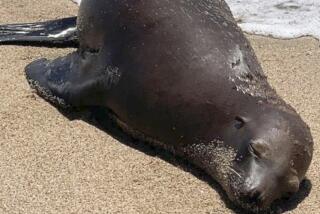Shark Kills Santa Barbara Skin Diver
- Share via
SANTA BARBARA — A shark, apparently a great white, killed a commercial diver in the waters off San Miguel Island on Friday--the state’s first confirmed death from a shark attack in nearly six years.
Santa Barbara resident James Robinson, 42, was treading water near his boat when the shark swooped in for a swift, brutal attack.
Robinson had just finished a routine dive to scout for sea urchins and had deposited his equipment aboard his boat. His two crew members were putting away the equipment when they heard Robinson scream--and whirled around to see him drifting unconscious in a gush of blood.
“His right leg was nearly severed, and his left leg had puncture wounds on it,” said Francis Oliver, a diver who came to Robinson’s aid after hearing his crew mates’ distress call. “It was pretty gruesome.”
A veteran diver, Robinson was attacked about 9:45 a.m. half a mile off the coast of San Miguel Island, which lies about 40 miles west of Santa Barbara.
*
Crew members on Robinson’s boat, the Florentia Marie, tried to revive him but could not find a pulse. A Coast Guard helicopter rushed Robinson to Goleta Valley Community Hospital, where he was pronounced dead of massive trauma at 11:15 a.m.
Neither of the crew members saw the attack. But Coast Guard officials said they believe Robinson was targeted by a great white shark, a keen-eyed predator that can grow up to 20 feet long and can sink its serrated teeth through a surfer and surfboard with one swift bite.
“They say it’s like a bullet . . . you never see the one that hit you,” urchin diver Jeffery Gunning said. “I just hope it went quick for Jimmy.”
Before entering the sea urchin business, Robinson had worked for years as a deep-sea diver for an offshore oil rig in the North Sea near the English Channel.
After settling in Santa Barbara, he quickly absorbed the California lifestyle.
Deeply tanned, with blond curly hair and an athletic build, Robinson loved surfing and diving--any activities that would keep him in the sun or in the water. Gracious and vivacious, Robinson was popular both in the harbor and in the neighborhood.
“You always hear about the good dying young, and golly, this guy was just one of the best,” longtime diver Steve Rebuck said. “He will really be missed.”
Most professional divers realize that great white sharks haunt the waters around San Miguel Island, where they feast on seals and sea lions. But their lurking presence has not deterred divers from prowling the ocean floor for valuable sea urchins, abalone and lobsters. It is a threat most divers take in stride.
“If you’re frightened by it, you have no business being in the business,” Rebuck said. “More people are killed by lightning and bee stings than by shark attacks.”
Although great white sharks bump, bite and scare several people a year in California, fatalities are rare.
No deadly attacks have been confirmed since UCLA graduate student Tamara McCallister was killed by a great white off Malibu in February, 1989. A kayaker, McCallister was found dead with a 13-inch chunk of flesh torn from her thigh.
In a more recent incident, a woman’s shark-bitten body was found off the San Diego coast last April. But the county coroner said the victim may already have been dead when the great white gnawed at her body.
*
To protect themselves from attack, veteran divers usually descend to the ocean floor as quickly as possible. Once on the bottom, they can hide among rocks and shadows. Eventually, however, they must rise to the surface, where their wet-suited bodies are vulnerable.
“It’s one of the risks of diving,” Gunning said. “We become part of the food chain when we enter the water.”
As a precaution, several divers in Northern California have begun to tuck plastic pistols in their wet suits before jumping into shark-infested waters, Rebuck said.
But most locals rely on a more low-tech survival technique: when face to face with a great white, they “say three Hail Marys and four Our Fathers,” diver Matt Barnes said.
In the waters around San Miguel Island, divers have learned to check for sharks by studying the behavior of the sea lions and seals that carpet the beaches. If the animals look spooked--or if any appear mauled--the divers know to stay away.
Even the best precautions, however, are not fail-safe.
Sharks sometimes attack humans out of pure curiosity, marine biologist Gary Davis said. And they sometimes confuse divers in wet suits for sleek seals.
“They spend a lot of time bumping things on the surface and seeing if anything falls off,” Davis said. “If it does, they taste it, to see if it’s something good to eat.”
Divers are willing to face such risks in part because the sea urchin business can be quite lucrative. Divers earn $1 to $1.60 a pound for the prickly animals, which look like bristling pincushions. Sea urchin roe is a delicacy in Japan, prized for its rarity, freshness and delicate taste.
Times staff writers Constance Sommer and Julie Fields and correspondents Paul Elias, Jan Stevens and Kay Saillant contributed to this report.
More to Read
Sign up for Essential California
The most important California stories and recommendations in your inbox every morning.
You may occasionally receive promotional content from the Los Angeles Times.










